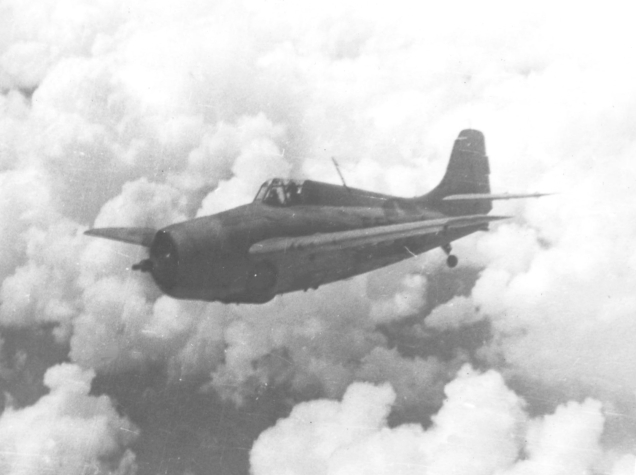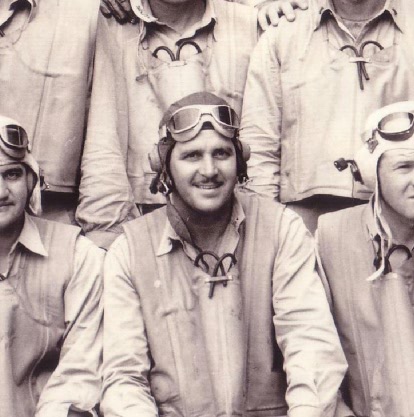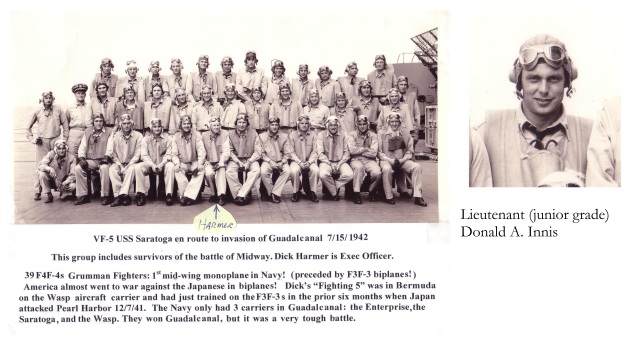While I was searching again on how to paint Marion Dufilho’s Wildcat, I stumbled upon this blog…
https://forgottenhobby.wordpress.com/2017/01/31/grumman-f4f-4-wildcat-of-fighting-squadron-5-vf-5/
Mine!

A U.S. Navy Grumman F4F-4 Wildcat of Fighting Squadron 5 (VF-5) during a flight out of Guadalcanal. VF-5 had been based aboard the aircraft carrier USS Saratoga (CV-3). Most of her air group was flown to Guadalcanal after the carrier had been torpedoed on 27 August 1942. VF-5 operated 24 Wildcats from Guadalcanal but, after five weeks, only five aircraft remained operational. (Wikipedia)
How to paint my Wildcat?
Hard to tell the right shade of blue when you start searching on the Internet. F12 would be how I want my F4F to look.

F12 was flown by Pug Southerland who was on this group picture.

Collection Richard Harmer (courtesy Tom Harmer)

Pug Southerland
At the beginning of the Battle of Guadalcanal, August 7, 1942, American forces shelled Guadalcanal and neighboring Tulagi in the Solomon Islands. Soon after the attack began, 27 Japanese bombers and an escort of 17 fighters took off from Rabaul, Japan’s stronghold and strategic base in the South Pacific. Their mission was to bomb the ships that were supporting the American attack.
Lieutenant Southerland commanded a group of eight American Wildcats aboard the USS Saratoga as a part of VF-5. Due to planning errors and the loss of planes to a recent training exercise, this was the only fighter cover available to patrol the landing area. Southerland (flying Wildcat F-12) and his flight took off to intercept the Japanese bombers before they could reach the American ships.
Southerland shot down the first Japanese aircraft of the Guadalcanal campaign, a G4M1 “Betty” bomber of the 4th Kōkūtai, under the command of Shizuo Yamada. After shooting down a second bomber, Southerland was engaged in a dogfight with an A6M2 “Zero”, piloted by Yamazaki Ichirobei of the Tainan Kōkūtai. He lined up the Zero in his sights only to find his guns would not fire, probably due to damage from fire by the tailgunner from the second bomber he had downed.
Although he was now defenseless, Southerland had to stay in the fight. Two more Zeros engaged him, as Kakimoto Enji and Uto Kazushi joined Yamazaki’s assault, but he successfully outmaneuvered all three of them. Southerland analyzed their tactics. Two fighters worked their runs from opposite flanks, while the third waited to take its turn. He coolly and carefully executed his defensive maneuvers. The dogfight was spotted by Saburo Sakai. Sakai also joined the battle. These Zeros finally shot down Southerland’s Wildcat, striking it below the left wing root with his 20mm cannon. Yamazaki, Uto and Sakai shared Southerland’s Grumman kill. Southerland later wrote:
My plane was in bad shape but still performing nicely in low blower, full throttle, and full low pitch. Flaps and radio had been put out of commission…The after part of my fuselage was like a sieve. She was still smoking from incendiary but not on fire. All of the ammunition box cover on my left wing were gone and 20mm explosives had torn some gaping holes in its upper surface…My instrument panel was badly shot up, goggles on my forehead had been shattered, my rear view mirror was broken, my plexiglass windshield was riddled. The leak proof tanks had apparently been punctured many times as some tuel had leaked down into the bottom of the cockpit even though there was no steady leakage. My oil tank had been punctured and oil was pouring down my right leg.At this time a zero making a run from the port quarter put a burst in just under the left wing root and good old 5-F-12 finally exploded. I think the explosion occurred from gasoline vapor. The flash was below and forward of my left foot. I was ready for it…Consequently I dove over the right side just aft immediately, though I don’t remember how.[1]
As Southerland bailed out of his doomed Wildcat, his .45 caliber automatic pistolcaught in the cockpit. He managed to free himself, but lost his pistol, leaving him weaponless, wounded, and alone behind enemy lines. Suffering from eleven wounds, shock and exhaustion, Southerland struggled through the brush, carefully evading Japanese soldiers. He finally reached the coast, where he was found by some natives, who at the risk of their own lives, fed him and treated his wounds. With their assistance, he eluded Japanese ground forces and returned to American lines. Southerland was evacuated from Guadalcanal on the first patrol boat to land at Henderson Field, on August 20, 1942.
On February 14, 1998, the wreckage of Southerland’s Wildcat was found, including his pistol. Investigation of the remains confirmed these accounts of the dogfight.
Source Wikipedia
About the original caption under the group picture…

Original caption
Tom Harmer told me he did not know who wrote the caption. It’s most certainly not his father when you look at the original caption!
Whoever wrote it, Tom told me I could edit the caption.

Half of these men died in the battle…?
I know this is not true. I know how many died.


Lieutenant (Junior Grade ) Donald A. Innis

Ensign Robert L. Price

Lieutenant (Junior Grade ) Charles A. Tabberer
Two more would die later over Guadalcanal when VF-5 pilots would join the Cactus Air Force.

Source: http://www.daveswarbirds.com/cactus/cactus.htm

Ensign C.E. Eichenberger
(arrived 11 September, 1942, killed in crash after combat 12 September, 1942)

Ensign G.J. Morgan
(arrived 11 September, 1942, missing in action 2 October, 1942)
About Marion Dufilho’s Wildcat? I could not find his plane number, but at least I have a good idea on how to paint it.

About Marion Dufilho?
This is what I wrote on another blog of mine.
Lieutenant Dufilho is the eleventh pilot I am remembering. 28 more to go. 28 weeks. The last one will be Richard “Chick” Harmer who survived the war.

Lieutenant Marion William Dufilho
I found these citations about this pilot.
Marion William Dufilho
Date of birth: May 22, 1916
Date of death: MIA: August 24, 1942
Burial location: Manila, Philippine islands
Place of Birth: Louisiana, Opelousas
Home of record: Long Beach California
Status: MIA
Marion Dufilho graduated from the U.S. Naval Academy at Annapolis, Class of 1938.

Navy Cross
Awarded for actions during the World War II
The President of the United States of America takes pride in presenting the Navy Cross (Posthumously) to Lieutenant Marion William Dufilho (NSN: 0-81070), United States Navy, for extraordinary heroism in operations against the enemy while serving as Pilot of a carrier-based Navy Fighter Plane and as Section Leader of the Fifth Division, Fighting Squadron FIVE (VF-5), attached to the U.S.S. SARATOGA (CV-3), in action against enemy Japanese forces in the Solomon Islands, on 7 August 1942. Upon sighting a hostile force of eleven dive bombers intent upon raiding our transports and other surface vessels, Lieutenant Dufilho, often pursuing his target through bursting shells of his own anti-aircraft fire, personally shot down two of the planes and damaged a third. By his cool courage and superb airmanship, he contributed materially to the success of our forces in a vigorous attack which destroyed a total of nine Japanese bombers and effectively disrupted the enemy’s plans. The conduct of Lieutenant Dufilho throughout this action reflects great credit upon himself, and was in keeping with the highest traditions of the United States Naval Service.
General Orders: Authority: Board of Awards: Serial 28 (March 2, 1943
Action Date: August 7, 1942
Service: Navy
Rank: Lieutenant
Company: Fighting Squadron 5 (VF-5)
Division: U.S.S. Saratoga (CV-3)

Distinguished Flying Cross
Awarded for actions during the World War II
The President of the United States of America takes pride in presenting the Distinguished Flying Cross (Posthumously) to Lieutenant Marion William Dufilho (NSN: 0-81070), United States Navy, for heroism and extraordinary achievement while participating in aerial flight as Pilot of a Fighter Plane during the Solomon Islands Campaign on 24 August 1942. During the air attack by Japanese bombing planes on U.S. Naval forces he flew to intercept the Japanese bombing planes but was fiercely attacked by an overwhelming force of enemy “Zero” type planes. He aided in shooting down the enemy planes until he himself was shot down. He gallantly gave his life in the service of his country while aiding materially in demoralizing the enemy air attack. His courage throughout was in keeping with the highest traditions of the United States Naval Service.
General Orders: Commander in Chief Pacific: Serial 24 (November 12, 1942)
Action Date: August 24, 1942
Service: Navy
Rank: Lieutenant
These pictures and documents were shared by Marion Dufilho’s grand-nephew.

Marion is on the left

Marion is on the right

Marion wrote his parents on July 31st, 1942.









Back in 1939, Marion wrote this…
 Thanks to his grand-nephew we will be remembering Marion Dufilho from generation to generation.
Thanks to his grand-nephew we will be remembering Marion Dufilho from generation to generation.
Click here.



77 years-ago on August 24, 1942, Marion Dufilho became part of WWII history.








































































